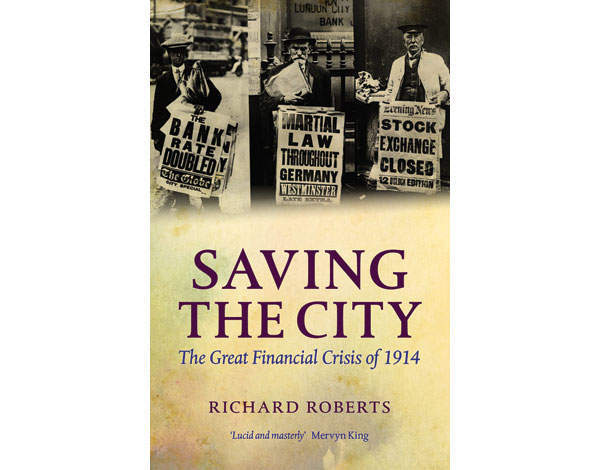

Saving the City: The great financial crisis of 1914
Richard Roberts
EX LIBRIS
‘The financial crisis of 1914 was the most severe systemic crisis London ever experienced,’ writes Richard Roberts in his opening chapter, and yet few historians were aware of it until now. Three books on the subject were published in its immediate aftermath and it appears in David Kynaston’s history of the City.
Yet it was entirely absent from Charles Kindleberger and Robert Aliber’s 2011 history of financial panics. So we should be thankful that Roberts has devoted an entire book, though not one that is over-long, to this fascinating forgotten episode.
The crisis unfolded thus. There was a period of breakdown, starting with Austria’s ultimatum to Serbia on 23 July, during which the prospect of a European war began to be an imminent possibility. On Friday 31 July, the Friday before the August bank holiday, the Stock Exchange closed at 10.15am amid an atmosphere of excitement and mild outrage, though not one of panic. The Manchester Guardian described the brokers and jobbers milling around in Throgmorton Street that morning as ‘swarming ants around the destroyed heap’.
The problem was relatively simple: remittances from other countries were drying up and the sudden plunge in confidence was causing everyone to sell shares. ‘All sellers and no buyers meant that markets quickly ceased to function,’ explains Roberts.
Once the Stock Exchange had closed, the Bank of England and the Treasury had to swing into action to contain the crisis as it spread through the system.
Not only did the joint-stock banks have investments of their own, but they also held large amounts of securities as collateral. With the Stock Exchange closed, at least these securities were no longer in free fall, but at the same time they were rendered completely illiquid. The breakdown of foreign remittance spread to the accepting houses, as merchant banks were then called, and the result of payments moratoria in other countries was that ‘all remittance to London by bill was virtually impossible, preventing debtors, however solvent and willing, from meeting their obligations in that way.’
London was the victim of its own pre-eminence as a global financial market. ‘London was the world’s banker, as it has so often boasted, and it said to the world, Pay up,’ wrote Hartley Withers in his 1915 book War and Lombard Street. But ‘there was no other banker to which the world could apply, no other centre in which there is an accumulation of capital and a machinery of credit capable of financing the world’s financial requirements.’
Eight accepting houses were unable to obtain remittances from the Continent and were ready to declare themselves insolvent. A moratorium on bills was imposed, with the Bank of England buying them on behalf of the accepting houses in much the same way as today’s Bank has been buying gilts. By the end of the war, Lloyd George told the House of Commons, there would be about £50 billion in what he called ‘cold storage’.
The next problem was gold. Since Britain and most other countries in the world had their currencies fixed to the gold standard, there was a danger that the public would panic and start hoarding gold or demanding coins instead of banknotes. But a greater problem was the fact that the joint-stock banks, fearing runs, began hoarding gold themselves and thereby created a gold shortage at the Bank of England.
Much of this phase of the crisis boiled down to a struggle between the greed and lack of civil-mindedness of the joint-stock banks, as Keynes correctly identified it, and the imperative for the Treasury and the Bank of England to stabilise the situation.
The solution was to obtain parliamentary approval for the suspension of the Banking Act, which limited the ratio of paper money to specie (coins), although in the end the threat of suspension, when combined with the speedy issue of Treasury (as opposed to Bank of England) smaller-denomination bank notes of £1 and ten shillings, was sufficient to calm the system.
The third phase of the crisis, which Roberts thinks is better described as a ‘revival’ than a resolution, took about five months, and the Stock Exchange reopened on 4 January 1915.
The Treasury’s and the Bank of England’s responses to the crisis amounted to a major exercise in state intervention. One unexpected result was that the joint-stock banks, eager to improve their balance sheets, increased their deposits at the Bank of England, and this helped the Treasury when it needed a war loan. Also interesting is that the cold storage of commercial bills and other interventions ‘netted the Treasury a nominal profit of £6.5 million’.
Roberts has made a distinguished and scholarly contribution to the genre of financial history, and yet his account of the various back-room negotiations between politicians, bureaucrats and bankers has all the elements of a thriller.






